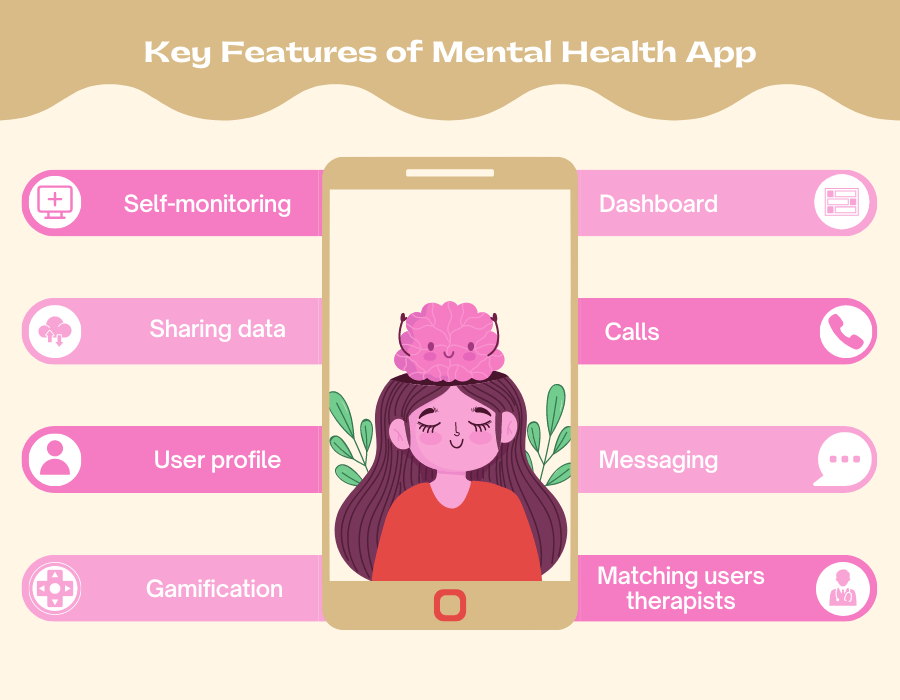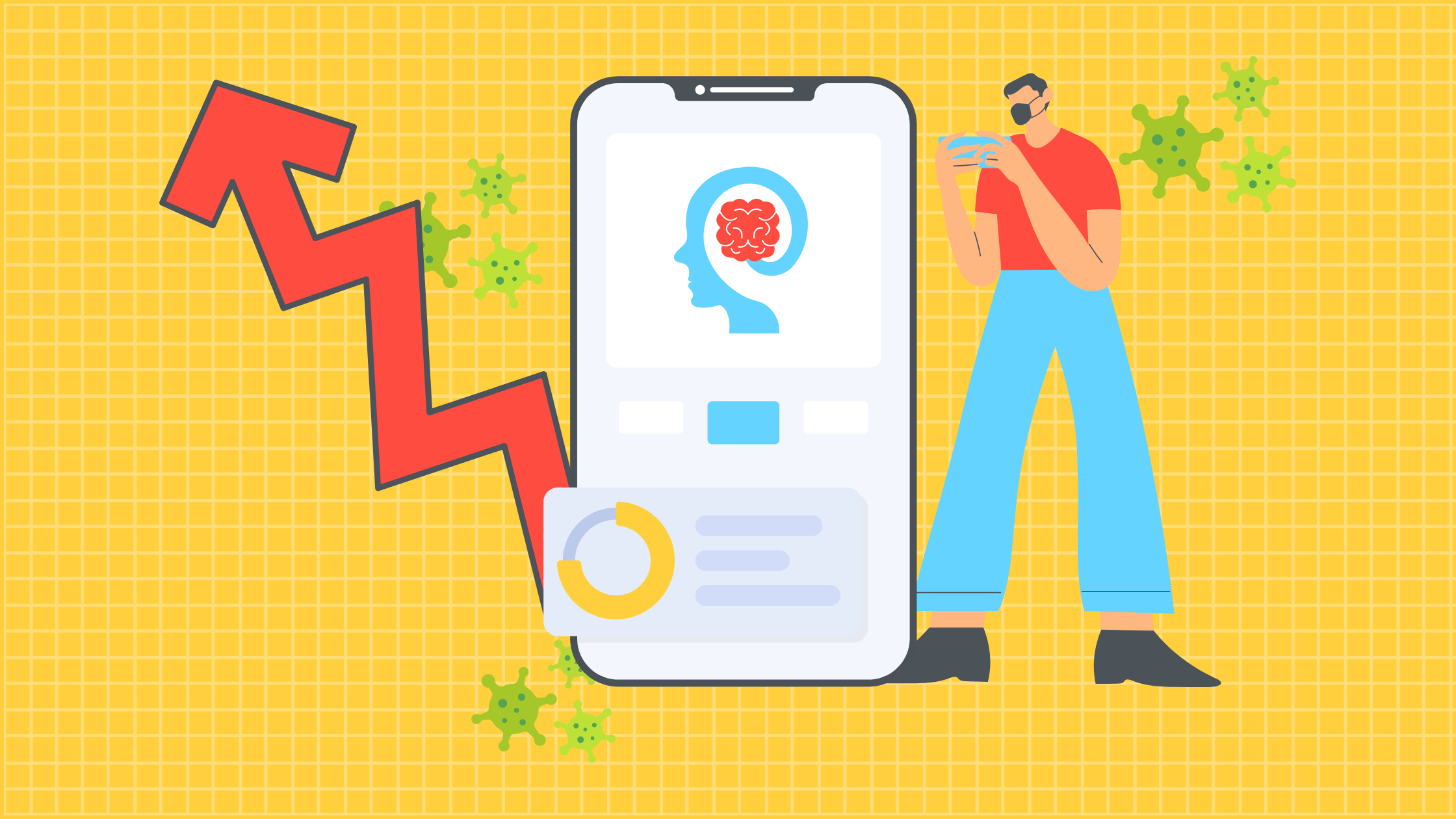While being stuck at home for almost a year, the isolation, lack of social contact, prevailing fear of the virus, economic uncertainty, unemployment, and what not happened! The mental health of everyone took a toll, the stress, the uncertainty was killing people from within. However, this was also an apt opportunity for the app development industry to come up with creative app ideas to help people maintain their mental wellness. And so, they did! The last year saw a sudden surge in mental and emotional wellbeing apps downloaded across the globe, this led to further development in this sector.
Mental wellness apps and digital therapy are likely to become even more popular in the future. Therapeutic counselling apps were already gaining traction among people dealing with issues ranging from stress to major mental illness when the COVID-19 outbreak erupted. When offices turned virtual, mHealth apps carved out a niche for themselves in the mental health industry. While some apps connect you with a qualified therapist, a large chunk of the industry has gone fully digital. Friendly chatbots provide (CBT) cognitive behaviour therapy; mood monitors remind bipolar disorder patients to keep track of their mood, and applications for treating (PTSD) post-traumatic stress disorder claim to assist individuals to get over acute bouts by guiding them through deep breathing exercises.
Mental wellbeing is getting much-needed importance now, and this is great! However, traditional therapy sessions are not for everyone for a variety of reasons. Let’s face it, mental healthcare is both expensive and still taboo for many. What can you do if you can’t afford treatment but are having trouble managing your mental illness on your own? You may use a mobile app. Smartphone users have had access to several mental health applications in recent years. These low-cost or free mental healthcare apps provide a diversity of tools that make counselling techniques more accessible, flexible, and cost-effective.
These days, it seems like there’s an app for everything, and mental health is no different. Mental healthcare is in high demand across the world. Apps may provide help on the go and on-demand. According to Deloitte, global investment in mobile mental mHealth apps would approach $500 million in 2022.
Given the increasing importance of creating a mental health app in recent years, it’s high time for us to tell you all you need to know about doing so!
So, let’s get started.
First off, we’re going to look at a few of the best mental and emotional wellbeing apps that have helped many people cope with their stress levels and even severe mental health issues.

Find more statistics at Statista
As per Statista Calm and Headspace are leading in the mental wellness apps.
1. Calm

The calm app has an amazingly pleasing UI and vast options for users to relax and self-care. It offers sleep stories, breathing programs, guided meditations, breathing programs, and calming music to those who are stressed or anxious. They have guided meditation courses for both beginners and experts, hence catering to all.
2. Headscape

Meditation is made easier using the Headspace app. Hundreds of meditations on anything from stress and anxiety to sleep and focus are available at your fingertips. The app also includes a helpful “get some headspace” reminder to motivate and encourage users.
Furthermore, many mental health app makers are collaborating with other apps, such as Snapchat in collaboration with Mariwala Health Initiative, which launched mental health support in India to make their products more accessible to a wider audience.
Apps can be used to control mental health problems like anxiety, OCD, or depression on their own or in hybrid form by incorporating traditional talking sessions too. Apps may be used to promote overall well-being by promoting behaviour change, such as practicing mindfulness and meditation, in addition to aiding those with mental health diagnoses.
How to create the best mental wellness app?

Do you want to create an app that stands out in the market and helps billions of people? Check out the key points below while creating your mental wellbeing app.
1.AI enabled app
AI has the power to take your app to altogether next level. It’s hard to train machine learning algorithms at actual patients while using a mobile app like this, which makes having an option for seamless human switching even more vital.
Chatbots are being used in a variety of ways not just within e-health, and they are usually promoted as being similar to in-person treatment. In general, MHealth apps, particularly those that use chatbots, have shown promise in assisting patients in maintaining wellbeing between in-person visits to their mental health professionals, such as through individual counselling.
Mental illness being an extremely sensitive topic needs a well-trained chatbot, hence it is the most difficult step.
With the use of AI, you can also incorporate in your app progress and recovery predictors and analysers to keep your user motivated.
2. Calming UI
The app is meant to calm and relax the users and hence the colors and aesthetics should be pleasing to the eye as well as easy to use. For example, you can feature templates in pastel colors that appear to be soothing. This will encourage users to seek mental health apps assistance. Patients may be frustrated by bright and bold graphics.
Along with well-balanced UI and UX, proper attention must be given to the in-app, reminders and notifications sounds too. The sounds must not be too harsh, as they will defy the purpose of calming the user. Instead you may use nature’s sounds like the pleasant chirping of birds, flowing water or, heart-warming flute music.
3. Data Security
People care about their data and are unwilling to put it at risk; therefore, data security is a major factor.
The data of a patient is private and should be encrypted at all times. Anyone with access to a patient’s data has the potential to misuse it. They have the potential to abuse their personal information. The patient may be emotionally and psychologically traumatized as a result of this.
To avoid this, it’s critical to keep the patient’s information hidden. Only the patient or their therapist should have access to it. Stored and exchanged data must be encrypted at all stages in order for an app to adhere to HIPAA, the GDPR, and PIPEDA guidelines. Furthermore, face recognition, fingerprint scanners, voice scanners, or other biometric authentication techniques must be used to enable safe entry to personal accounts.
4. Motivational reminders
One of the main pursuits of any mental health app is to provide its users with much-needed positivity and motivation. To motivate patients to stay on track and use the many features of your mental healthcare app to improve themselves, they should be given in-app awards for reaching key achievements.
This implies your mental health app must give rewards to users such as a positivity or wellness badge through gamification. You may also give away coupons or vouchers for the paid version of your app. Free consultations may also be included in the awards, which will aid them in obtaining something worthwhile.
5. Multiple platform support
In today’s world, most people utilize two gadgets. A laptop and a smartphone. Your user may also have a smartwatch or a tablet if he is a geek.
With so many alternatives available to consumers, it’s critical that your mobile app works on a variety of devices and is constantly accessible.
With Swing2App you can create an app for both iOS as well as Android simultaneously, without any coding at all! Yes, you read it right, entirely codeless app builder and, that too for free.
6. 24*7 Therapist assistance
Any patient in need of a mental health consultation should be able to get one online at any hour of the day. There should be some professionals available all the time for emergencies.
Users should be able to contact a therapist at any time of day via your mental health app. This function will assist the patient in calming down during an emergency. You can add a function that alerts a therapist whenever a patient requires assistance. This should work even if they are not connected to the internet. Counsellors who sign up to give services may work at any time of day or night. They may use a slot system for this, in which each therapist must be accessible during the specified hours.
To sum up
To put it in a nutshell, if you decide to create a mental health app, it is critical that it is evidence-based and that it offers users a privacy policy that ensures their data is safe and secure so that they feel comfortable using the app you design.
Additionally, a game-like component would encourage users to engage and enjoy the mental health app.
Swing2App is one of the best codeless mobile app development platforms. Do you have a plan in mind? Visit Swing2App no-code app building platform and create your own free mHealth app all by yourself. Moreover, we can assist you in developing customized mobile app solutions for your company.
